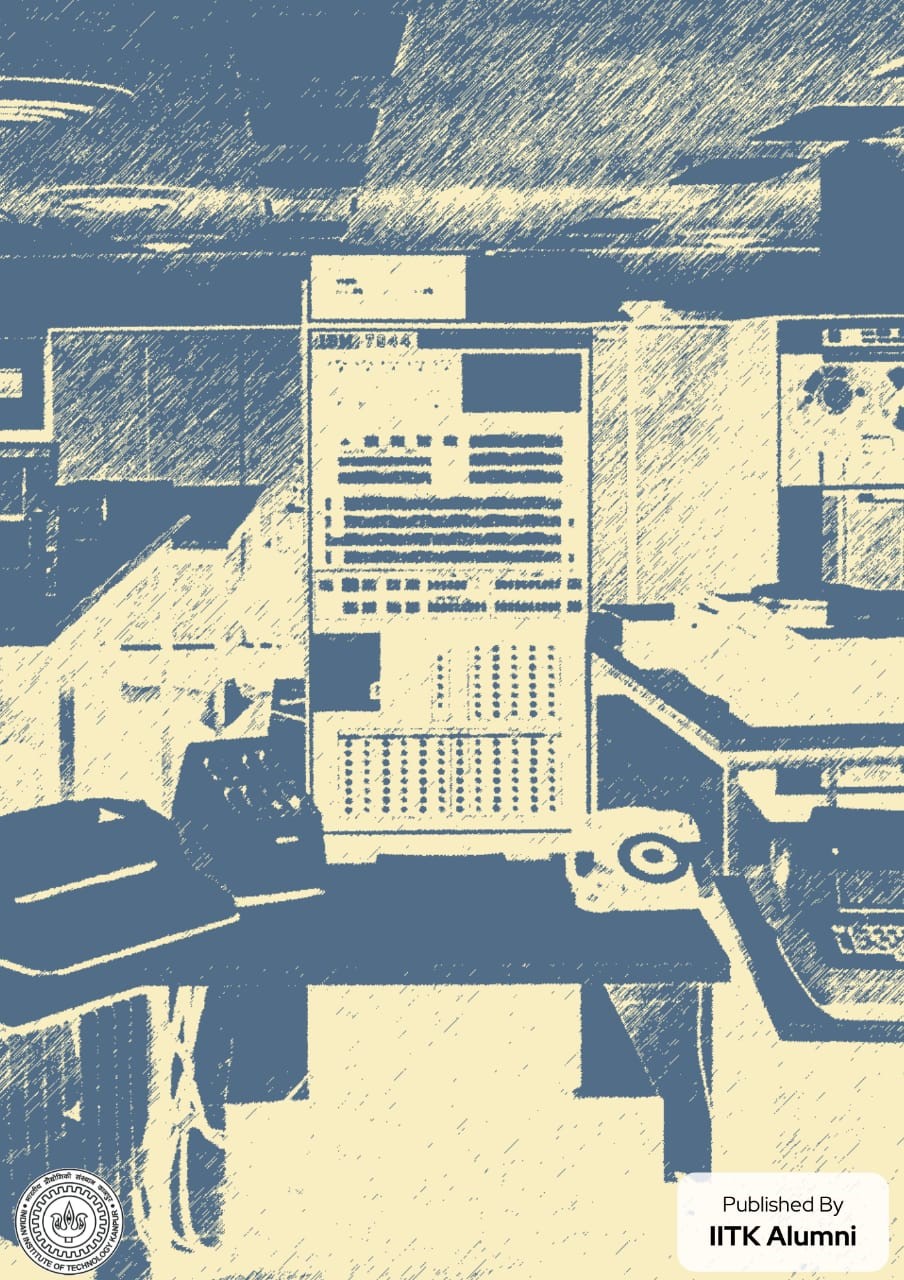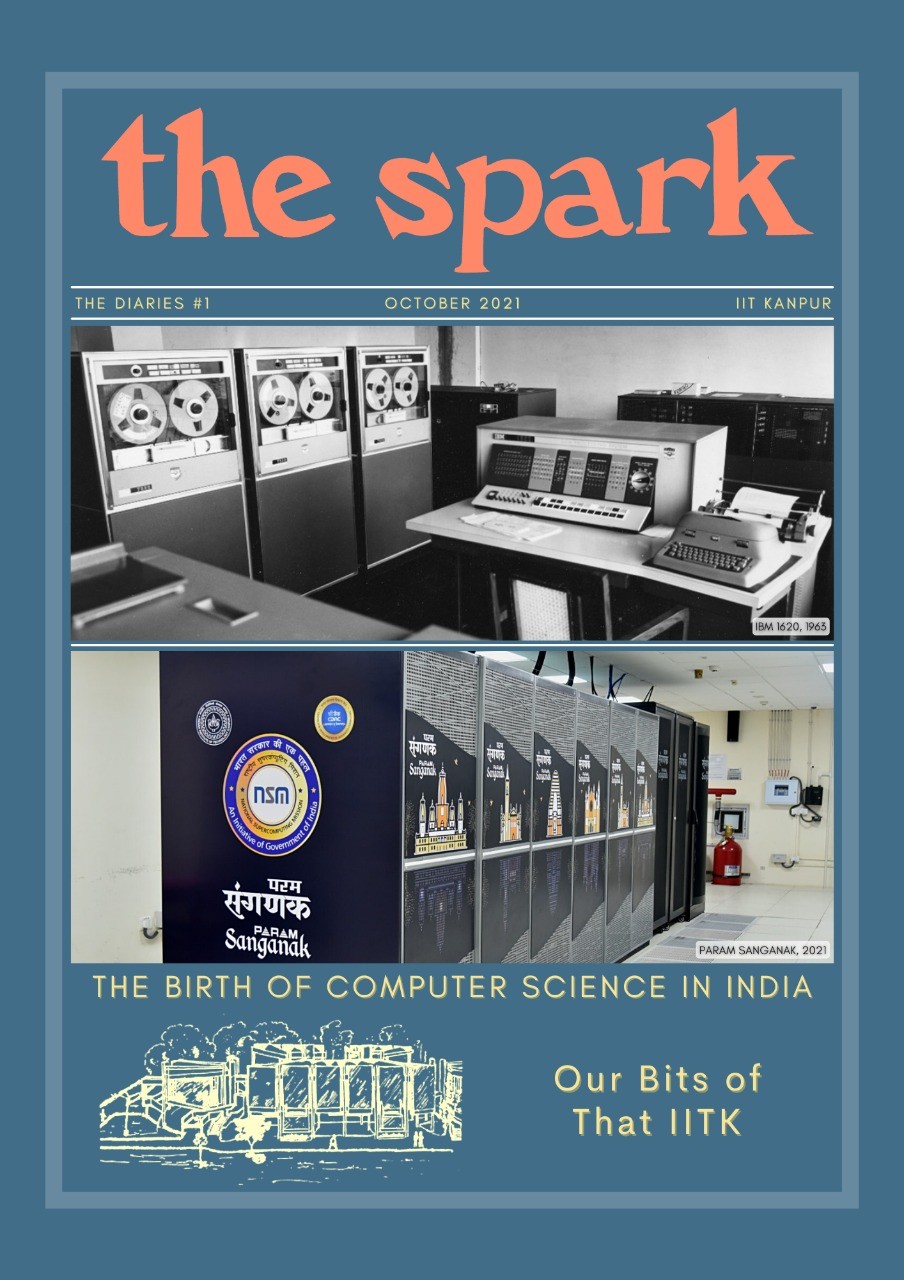
The Spark October 2021
The tired old anvil on which so many ideas have been hammered into shape, once more throws off sparks as a new literary idea is forged into form today.
The Spark, Vol. 1 No. 1, Feb 15, 1965
| Contents | Page |
|---|---|
Editorial - The Spark Returns |
2 |
The IBM 1620 – Introducing Computer Science in IndiaWith the arrival of the IBM-1620 IIT Kanpur became the first Institute to have a computer. |
4 |
Professor Harry Huskey -- Planting a TreeA legend in American Computing introduces classes to mark the first beginnings of Computer Science Education in India. |
11 |
Our Experiences on the 1620A former President of Avaya Labs recalls his early experiences in operating the 1620. |
17 |
A Larger Computer for the InstituteIn 18 months, the needs on the campus have outgrown the capabilities of its computer. |
22 |
Remembering Prof. Kesav NoriA tribute to Prof. Kesav Nori, a beloved educator, researcher, and wonderful human being who had spent several years at IITK. |
24 |
Our Bits of That IITKA collection of stories shared by the faculty, students, and alumni of IITK. |
27 |
Fifty-six years after the first, and thirty-two years after its last appearance on campus, the Spark returns as the voice of the alumni, celebrating our memories and showcasing today’s IITK.
A few years ago, a few alumni with a handful of photos and a plethora of memories created a Facebook group to share their stories. Three years and 4,000 members later, this group has the largest collection of IITK memorabilia anywhere. The return of the Spark is a natural evolution, sharing those memories and presenting today’s IITK to the rest of the world.
The first few issues will be theme based. This, the first issue, focuses on the technology that has changed our world – computers. At IITK, it was the arrival of the IBM-1620, which gave birth to Computer Science
Education in India. At a time when no educational institution in India had a computer, IITK got one, then two, then three machines. And we thought to ourselves…
What better way to kick off the Spark revival than with a celebration of the Computer Centre, the faculty, and the students (where all 20 seats in the department would fill up by AIR 30).
What better story than that of the first computer arriving on a bullock cart – it can happen only in incredible India!
What better a publication to tell that story than The Spark, the student magazine that was born during that era?
Historically, the Spark has been an independent publication, supported by contributed stories – that quiz where the top score was minus 2, that jump in the pool during a national swim meet for egg coupons – and financed by advertisements and old newspaper sales. We would like these issues to be no different, and want to include your stories in the coming releases.
For advertisers, we offer an outreach to alumni in leadership roles across hundreds of large multinational corporations, to engage and inform about your products and services. All proceeds from the advertising sponsorships will go to the IITK Foundation, providing another source of funding for worthy causes. Entrepreneurs and CXOs, your marketing teams will give an arm and a leg to get an audience of this quality!
To keep these Spark issues going we want your stories. Send in your tales, pull out your pictures and share them with us, either directly in the Facebook group “This Bit of That IITK”, or via email to:spark@iitk.ac.in. While every story is welcome, the immediate need is for pictures and stories from the Computer Centre from 1979 onwards, of the DEC-1090 and later systems, to get the next issue completed.
A big Thank You to the DORA office, Prof Jayant Singh, Ms. Gauri Sharma, and the Outreach Cell, for their help and support in publishing this issue. They have gone out of their way, taking time off from their busy schedules to support this project. Feel free to forward the email and the link to your family and friends. Reach out to those thinking of joining an IIT and tell them what K is all about!
Views and opinions expressed in The Spark are those of the Editors and Contributors and not those of the Indian Institute of Technology Kanpur, unless specified otherwise.
Editors: Aseem Shukla, Shirish Joshi, Chilukuri Mohan
Members/Contributors: Aditya Raghav Trivedi, Amrit Yegnanarayan, Angshu Das, Anurag Dikshit, Arvind Krishna, Arvind Kumar, Girish Pant, Gurpur Prabhu, Gyan Mehta, Kaushal Chari, Krishnendu Paul, Manoj Kumar Srivastava, Navpreet Singh, Nirmal Roberts, Nitin Saxena, Paul Joseph, Pradip Parikh, Pranshu Garg, Praveen Kulshreshtha, Raj Bhattarai, Raman Bhatia, Ravi Sethi, Sanjay Bose, Somenath Biswas, Suresh Reginald
Special Thanks to: Professors V. Rajaraman, Hari Sahasrabuddhe, Gio Wiederhold, and Ross Bassett, DORA Jayant Singh, Mr. Narayana Murthy, and the Dahl and Huskey families
Published by: IITK Alumni
The IBM 1620 – Introducing Computer Science in India
Aseem Shukla (BT, ChE, 1978-83)with assistance from Prof. Ross Bassett (Dept of History, North Carolina State University)
In July 1963 a chartered DC-7 landed at the Air Force base in Chakeri, Kanpur. Among other equipment, it carried an IBM-1620, a commonly used computer in American Universities, now destined for the newly established IIT on the outskirts of the city.
With this arrival, IIT Kanpur became the first IIT to have a high-speed digital computer. By Feb 1964 the 1620 worked 24 hours a day and was recognized as the most active computer center in India. IIT Kanpur introduced a required course for all undergraduates in computer programming. Classes and seminars were offered on the campus not only for the students and faculty, but also for researchers and teachers in other institutions, to mark the first beginnings of Computer Science education in India.
Decades later, India and all Indians in general, would become synonymous with the Information Technology age, with these influences spreading from Bengaluru to Silicon Valley. It would, perhaps, mark the first example of a nation stepping out of colonial era poverty by educating its masses and using that knowledge to deliver services around the world.
The story of India’s journey into the digital age had actually started a few years earlier, in November 1961, with Prime Minister Nehru’s visit to the Kennedy White House. Among the discussion topics was US support for the new IIT coming up in Kanpur. With West Germany having already committed to the campus in Madras, and the Soviet Union supporting the institute in Bombay, the goal was clear: the American campus would have to be a class above. The US would provide aid in setting up the campus, and would also send faculty, equipment, and intellectual know-how to help create an institute comparable to any in the developed world.
Nehru and Kennedy at the White House, Nov 1961. Picture is from the JFK Library.
The Kanpur Indo-American Program (KIAP) would feature nine American universities – MIT, Caltech, Princeton, Purdue, Michigan, Ohio State, California-Berkeley, Carnegie (CMU), and Case (CWRU). Over the next ten years, faculty and equipment would make their way across the oceans to the new campus, graduate students would come over to the US for higher studies, and then return as faculty members, and IIT Kanpur would break a new path in defining the Engineering curriculum in India. The White House meeting was on November 7, with the KIAP announcement following on November 11. The significance of the dates was not lost… in colloquial lingo KIAP became the ‘birthday gift’ from Kennedy to Nehru.
John Kenneth Galbraith, the US Ambassador visited the campus of the new institute in October 1962. It really wasn’t much of a campus then, there were very few buildings, no auditorium, no lecture halls. Classes were being held at the Harcourt Butler Technical Institute, with students living in assorted hostels and private homes in the city. Ambassador Galbraith addressed the IITK community from a podium set up inside the workshops, the only functioning buildings at that time. Recognizing the challenges faced by the program in bringing faculty members over from the US, he ended up writing personal letters to the Presidents of each of the participating universities, seeking greater involvement in the project. Under his guidance, IIT Kanpur became the first institute in India to offer Computer Science education.
IIT Kanpur’s first director, Prof. P. K. Kelkar had been planning on installing a computer, even before the American participation was finalized. But when the American faculty came on board, their enthusiasm for a computer, both as an educational device and as a symbol of American technological supremacy, made it a priority. The IBM 1620 was brought into the Kalyanpur campus as soon as the construction of the required facilities was complete.
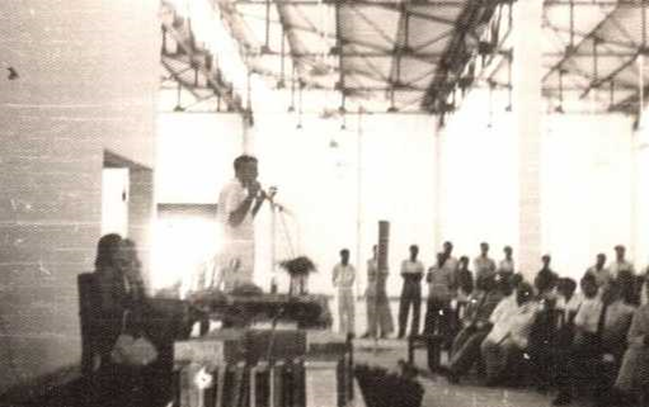
John Kenneth Galbraith addresses the IITK community, Oct 1962. Picture source: IITK archives.
The announcement of the new computer centre created a lot of excitement on campus. Letters were exchanged between Kanpur and the US universities, and there were press releases, some of which we have been able to obtain.
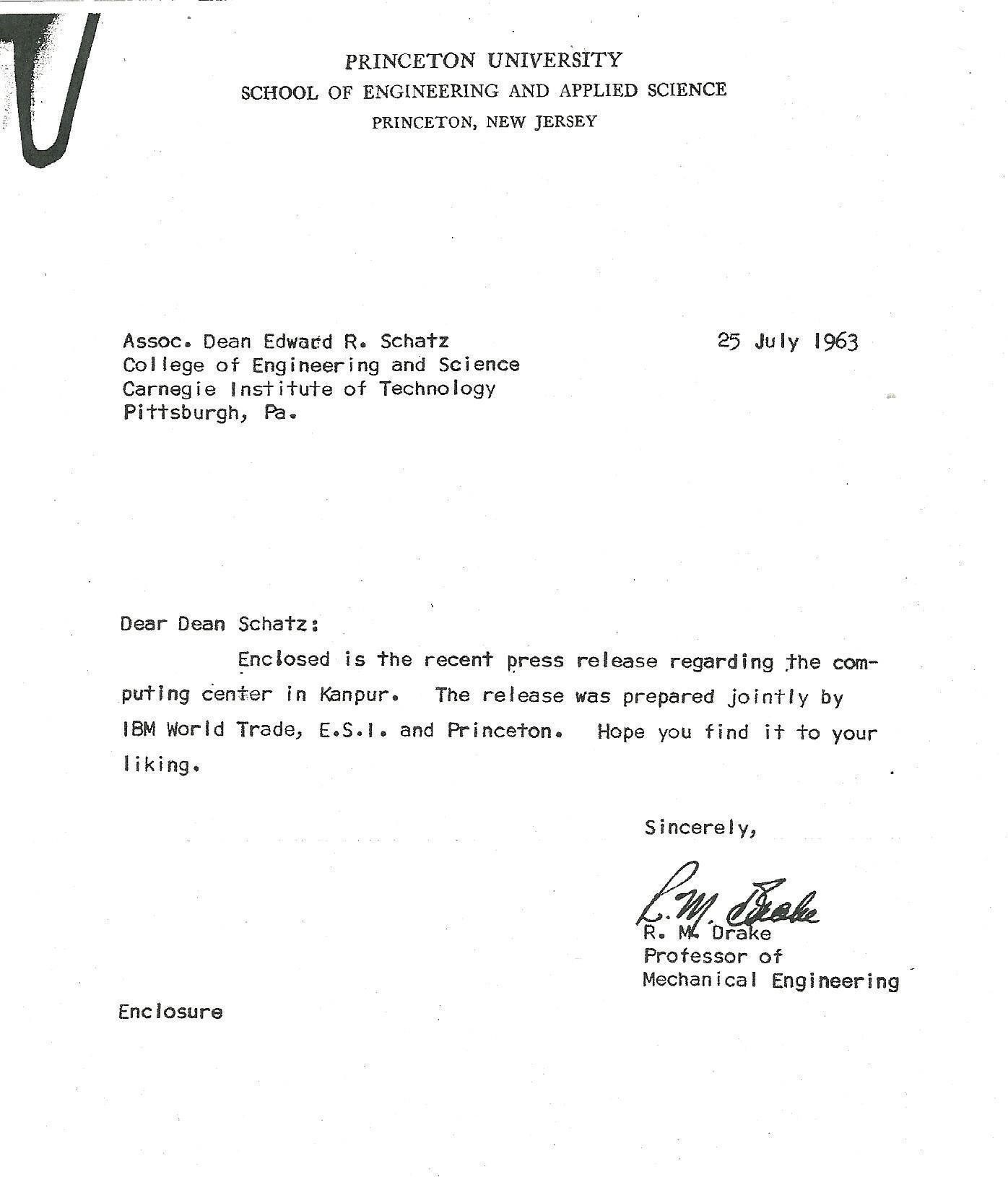
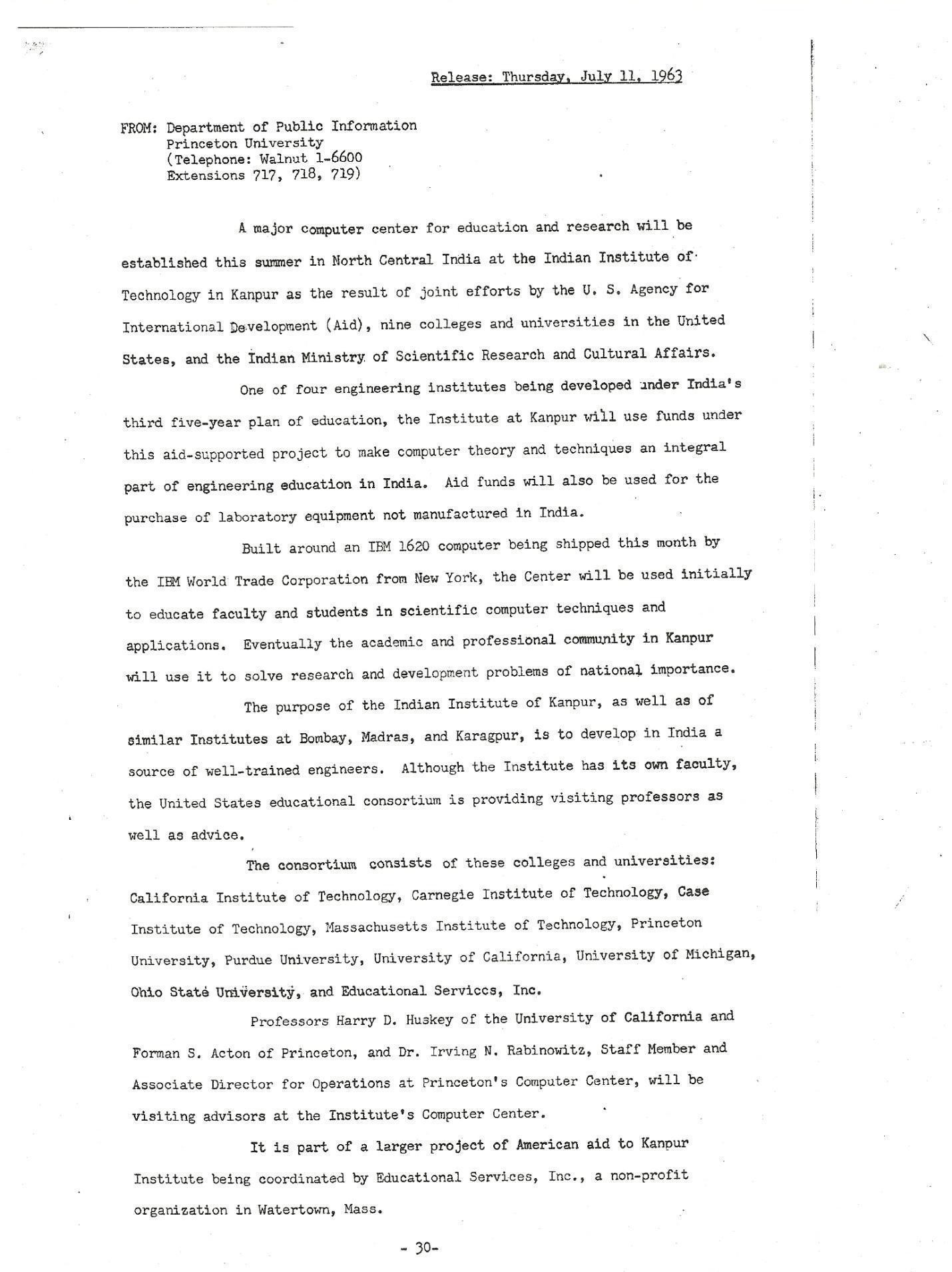
The task of bringing the computer to campus was assigned to Professor Harry Huskey of the University of California, Berkeley. Already a legend in American Computing, he had worked with Alan Turing in England on the design of the ACE computer and on the WW-II ENIAC project at UPenn. He had designed the Bendix G-15, a machine that could be operated by one person, and now regarded as America’s first ‘personal’ computer, which is on display in the Smithsonian Museum.
The 1620, along with some other equipment, arrived on a specially chartered DC-7 from New York. After a pit stop for refueling, and another for Customs inspections in Delhi, the plane landed at Chakeri. An Air Force truck then towed the equipment towards the campus. A dusty unpaved road from GT Road across the railway tracks, and going up to Hall I, provided the only access, and was used by all trucks to carry building materials to the site.
Now came the fun part… the dirt road was flooded in the monsoon rains, with more than a foot of water in some stretches, and possibly large potholes hidden underneath as well. David Huskey (Harry’s son) recalls that the trucks were very skeptical about completing this water
crossing; the shocks from the hidden potholes could have severely damaged the equipment. A tried and trusted form of transport was employed for the last mile, with a pair of oxen pulling the cart into the campus. The parallels with the transport of space equipment for ISRO satellite launches are remarkable!
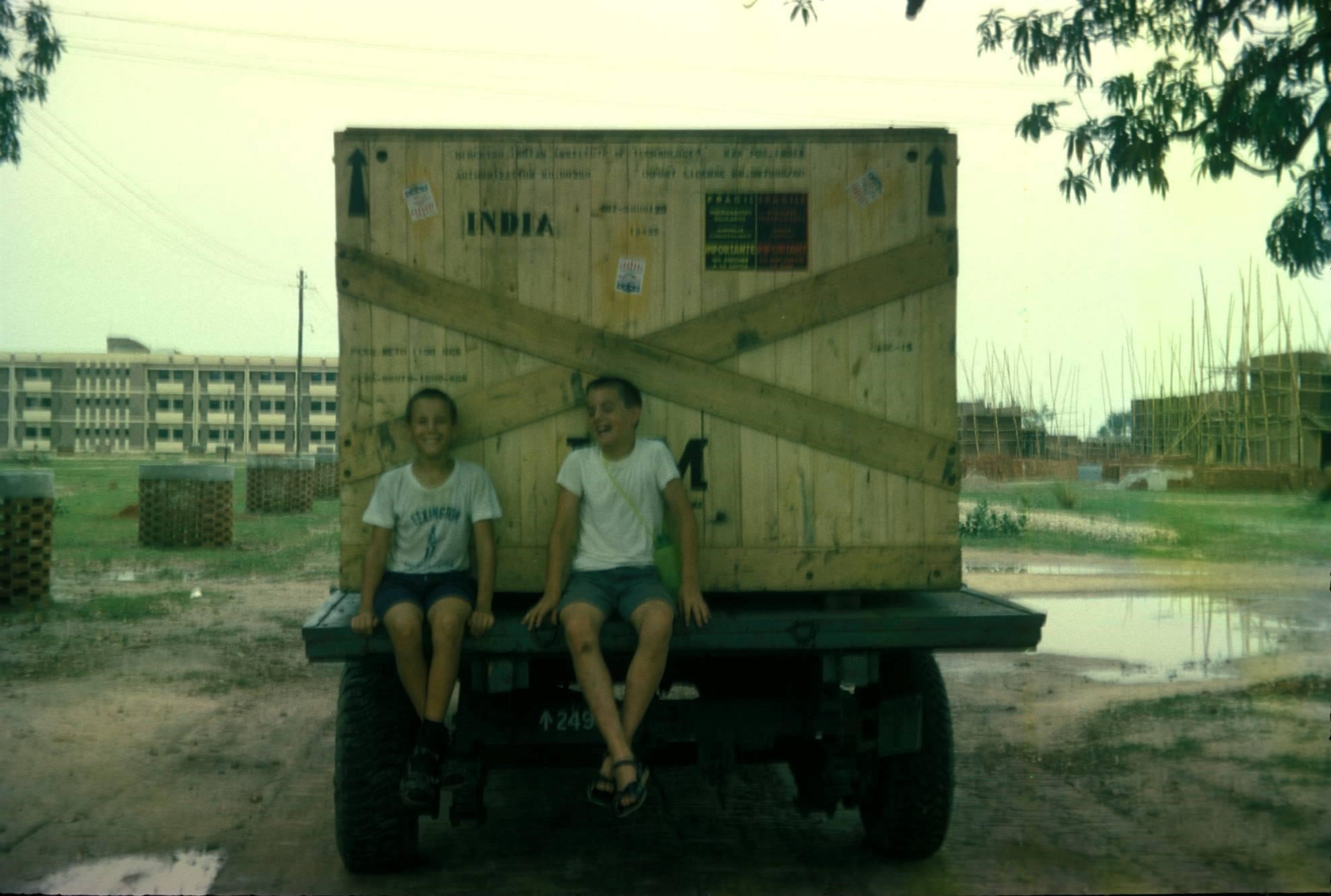
The trailer can be seen here, probably somewhere near the present Transport Section. Hall I is visible in the background, with Hall II under construction on the right. The two boys enjoying the joy ride are Chris Dahl and Doug Huskey, sons of Professors Norman Dahl (the first leader of KIAP) and Harry Huskey. Picture Credit: Mrs. Dorothy Dahl.
But despite his travels around the world, Harry Huskey was somewhat unprepared for what followed. The building intended to house the computer (Western Labs) was still under construction, in fact the computer room was letting in water during the monsoon rains. Without a proper access ramp more trustworthy techniques, such as team effort to push the cart were applied to get it into the building (did someone say building the pyramids!) before the forklift found a path to descend to ground level.
More drama followed when it was discovered that the door to the computer room was not wide enough to permit its entry and the wall had to be broken down before it could be unloaded!
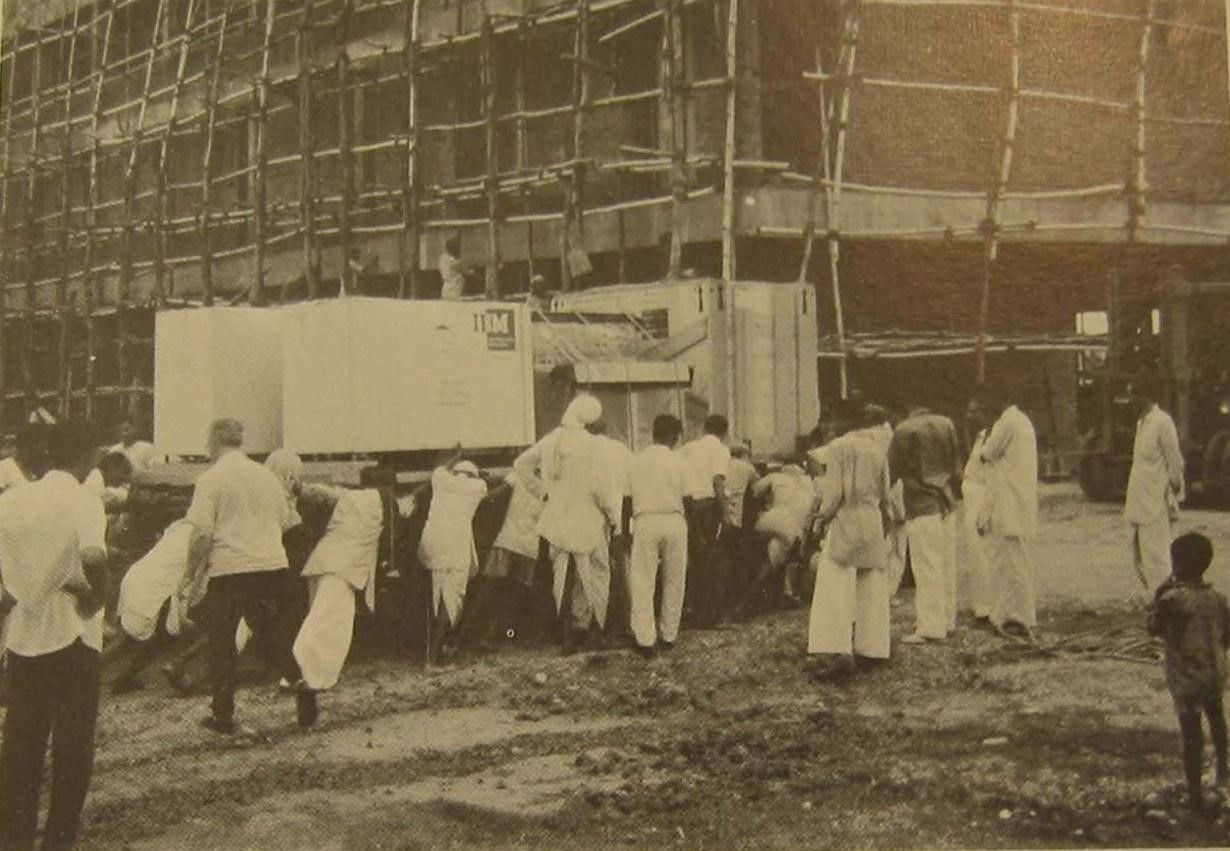
The iconic image of a team effort to push the cart over the hump. ‘Jor Lagao, Haisha!’ Source: Norman C. Dahl, "Revolution on the Ganges: A Report on the Indian Institute of Technology, Kanpur," Tech Engineering News, April 1967, Institute Archives, MIT Libraries, Cambridge, MA, photographer unknown.
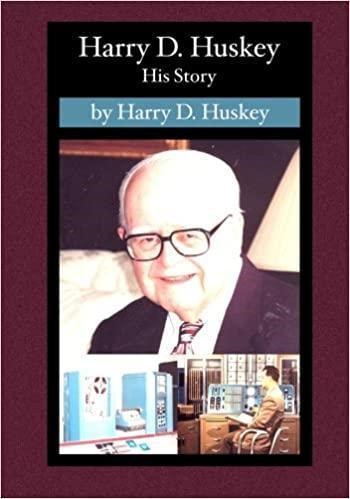
In his autobiography Harry Huskey wrote:
The Institute was under construction. I found the shell of a building in which the computer was to be complete but the walls and floor were not! The computer was scheduled to arrive in two weeks! The monsoon rains had come and much of the time, the floor of the computer room had an inch of water in it!
Surface shipment of items from the States was unreliable. They might sit for a week in the rain on the docks in Bombay. So the project chartered a DC-7 to ship laboratory equipment and the computer. The plane stopped in Delhi for customs inspection, but there was no manifest! The customs official threw up his hands and said “Take it to Kanpur and tell me what you find!”
The runway at the commercial airport in Kanpur was too small for a DC-7. We negotiated with the local air force base to use their runway and to use a couple of their trucks to accompany our fleet of rented trucks…
We unloaded the computer into a nearly finished room and unpacked. It was an IBM-1620 with three tape drives; the magnetic disks were not available when it was ordered. Because of USAID “Buy America” restrictions it was 60 cycles. India was on 50 cycles. The central computer was single phase, but the tape drives were three phase. We found a three phase convertor driving a three phase alternator at 50 cycles. It was almost as large as the computer…
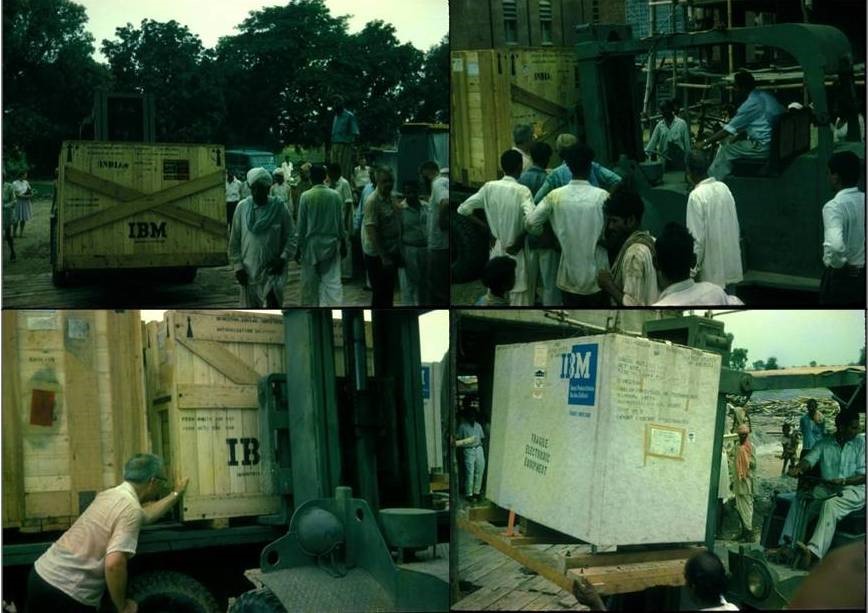
The computer is unloaded and placed in its new home. Picture Credits: Mrs. Dorothy Dahl
But in the end, it all went well. With a little help from Harry, the computer was placed into its new home. After a few configurational issues, the startup was successfully completed, and the journey into the new age had begun!
Professor Harry Huskey -- Planting a Tree
V. Rajaraman (Professor, CSE IITK, 1963-82) and Shirish Joshi (BT, ChE, 1973-78)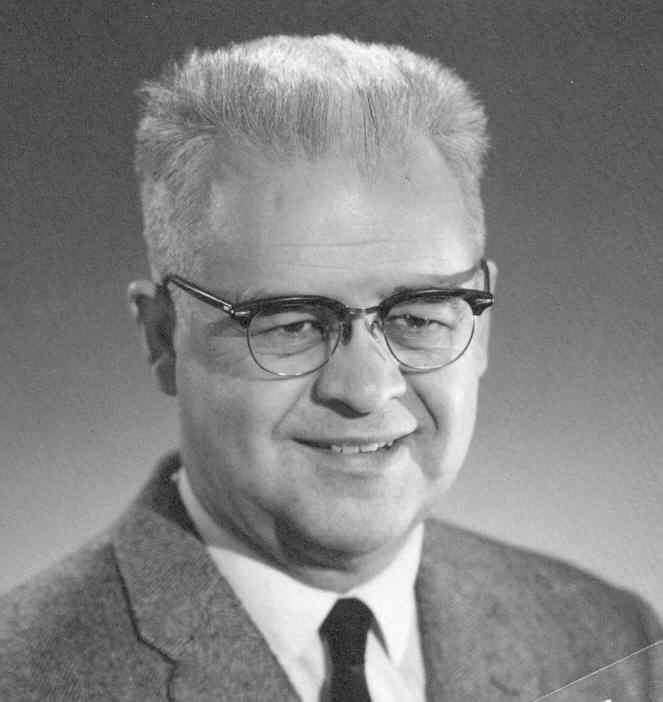
Harry Huskey was a Professor of Electrical Engineering at the University of California, Berkeley, when he first visited Kanpur in 1963. He, along with Professors Forman Acton and Irving Rabinowitz of Princeton University, had been requested to establish a Computer Centre by The Kanpur Indo American Programme (KIAP), a contractor of the United States Agency for International Development (USAID), which had the task of assisting India to set up an Institute of Technology at Kanpur.
USAID had purchased an IBM 1620, a transistorised computer that was popular in U.S. educational institutions, to be installed at IIT Kanpur. In July 1963, the IBM 1620 arrived on campus and was installed by IBM engineers. Professor Huskey and his team installed the systems and applications software, including FORGO, a load and go version of the FORTRAN II compiler developed at the University of Wisconsin at Madison.
Professor Harry Huskey was a pioneer in computing. He had been a member of the ENIAC team that built one of the first computers in the World. He had also worked with Alan Turing at the National Physical Laboratory in the U.K. in building the ACE computer. Besides these, he designed and built one of the first computers with a magnetic drum, the Bendix G-15. He was a versatile computer scientist who had the breadth of knowledge, not only to build computers but also to develop complex systems software. He designed a version of Algol called NELIAC (Naval Electronics Laboratory version of the International Algorithmic Language) while at Berkeley. Professor Huskey was one of the early Presidents of ACM, U.S.A., and a Fellow of ACM.

The IBM 1620 arrives at IITK.
Picture Credit: Mrs. Dorothy Dahl
The IBM 1620 was the first computer in an educational institution in India and also the first computer in India with a high-level programming language, FORGO. Professor Huskey as the leader of the American group designed what he called the "Ten-Day Intensive Course on Computation", intended for the faculty of IIT Kanpur and also scientists and engineers from other Universities and research establishments in India. The course consisted of Programming using FORGO, basic numerical methods, and computer logic. An important part of the course was a three hours laboratory session in which all the participants of the course wrote and executed programs using FORGO.The Late Mr. F.C. Kohli, co-founder and first CEO of TCS, and widely regarded as the Father of the Indian IT industry, had attended this class.

A discussion in progress at IITK Computer Centre, circa 1964. After the arrival of the IBM-1620 in 1963, IITK led the way in pioneering computer education in India. The earliest classes were in the form of seminars for educators and scientists. Professor Irving Rabinowitz is visible in the back corner of the table. Picture Credit: Professor Irving Rabinowitz, from Prof Gio Wiederhold’s KIAP Collection.
During Harry Huskey’s stay at Kanpur, the course was taught four times, once every three months. There were about 50 participants in each course. The course was very popular and after Harry left, the faculty at IIT Kanpur, whom he had trained, continued offering these classes. This course was instrumental in rapidly spreading computer education in India. Harry also initiated the formation of an IBM users· group with representatives of all IBM computers that were then functioning in India, most of them being IBM 1401s. The first meeting was held at the IBM education centre at Faridabad and became the forerunner of the Computer Society of India. In late 1964 Harry organized the first international symposium on computing to be held in India at IIT Kanpur. Luminaries from all over the world attended this conference, permanently putting IITK on the international CS map.
Professor Harry Huskey had a missionary zeal to spread computer education throughout the developing world. He spent a year in Burma (now Myanmar) in the late 60s and visited India again to assist Delhi University to set up their Computer Centre (with an IBM 1620) in the seventies. He also assisted an African country to set up a computer centre.
Harry was on the IITK campus for a year from July ’63 through July ’64, before returning for another semester-long visit in 1971. In 1986 he retired from the University of California, and in 1994 he was inducted as a Fellow of the Association for Computing Machinery. In 2013, the Computer History Museum named him a Museum Fellow "for his seminal work on early and important computing systems and a lifetime of service to computer education."
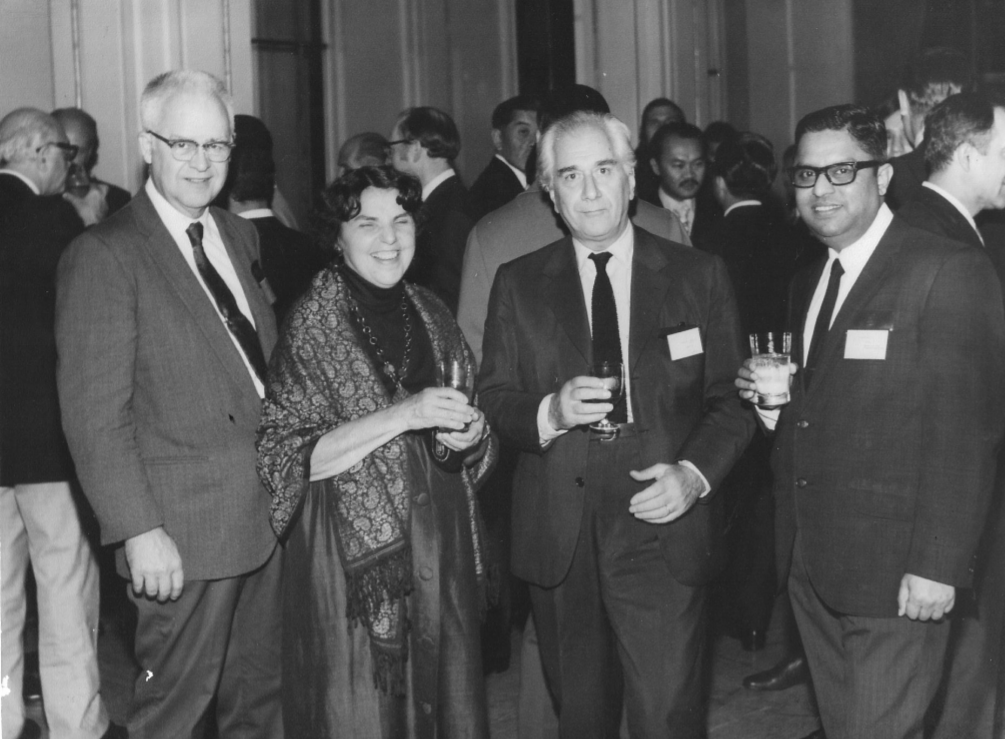
Prof V. Rajaraman, on the far right, with Harry and Velma Huskey on the left, at the Jerusalem Conference on Information Technology, 1971. Second from right is one of the Israeli delegates at the conference. Picture Credit: V. Rajaraman
He was an esteemed educator; his PhD students included Nicklaus Wirth (the designer of the Pascal programming language and compiler), and his mentees included Prof V. Rajaraman, the first Head of the CSE Department at IITK. Today, as India dominates the world stage in computer programming and back office support, it is important to recognize that almost all software programmers in India today, if they traced back their programming lineage, would end up under the tree that Harry helped to plant.
A few years ago, some IITK Alumni living in the Bay Area discovered that Prof Huskey had retired to an Assisted Living Home in Santa Cruz, California, not far from Silicon Valley, where he had his own PC, with email and internet access. In March 2017, after contacting him through email, some of us drove over to see him, wanting to meet this person who literally was living history. We had taken along to show Harry, pictures of the 1620 arriving on campus, prints of some of his own photos from the 1970s, and more pictures of the campus, as it looks today, hoping to jog his memory of those earlier events, along with the realization of what they had led to today.

Unfortunately, at 101 years of age, Harry was not able to communicate with us fully. He could hear and understand but was no longer able to talk. He really liked the pictures and kept them with him, very happy to remember the campus he had helped create so many years ago.
Harry Huskey passed away a few weeks later on April 9, 2017. We were thankful to have had the opportunity to share our thoughts with him in his final days. Several of us were present at his memorial service to offer our tributes.

Harry Huskey with the Bendix G-15. Now regarded as the first Personal Computer (primarily because it could be operated by just one person), this machine was inducted into the Smithsonian Museum of American History in 1988. Picture Credit: Dan Coyro, Santa Cruz Sentinel. Reprinted with permission.
Credits: The pictures have been shared by the Huskey family, unless indicated otherwise. Portions of this story have been adapted from a tribute written by Prof. Rajaraman that appeared in CSI Communications, May 2017.
The Symposium of High-Speed Computation Methods and Machinery, Dec 1964
Before he returned to the US in July 1964, Harry Huskey proposed to USAID that a conference on Computing and Computer Centers be held at Kanpur during the forthcoming Christmas-New Year Break. Once the proposal was accepted, Harry invited the worldwide leaders in computing, including: Forman Acton (Princeton), Robert Archer (Case Tech), S. Barton (CDC, Australia), S. Beltran (Centro de Calculo, Mexico City), John Makepeace Bennett (Univ of Sydney), Launor Carter (SDC), David Evans (UC Berkeley), Bruce Gilchrist (IBM-SBC), Clay Perry (UC San Diego), Sigeiti Moriguti (Univ of Tokyo), Gio Wiederhold (UC Berkeley), Adriaan van Wijngaarden (Mathematisch Centrum, Amsterdam), and Maurice Wilkes (Cambridge Univ), among a host of other participants. The galaxy of international dignitaries, attending a conference on a nascent campus with minimal infrastructure, permanently put IIT Kanpur on the International Computer Science map.
The symposium was held concurrently with the Ninth Congress of Theoretical and Applied Mechanics. There were over 225 visitors on the campus, who were accommodated in the IITK Visitor Center, with some delegates staying in the student halls. The Lecture Hall Complex had yet to be built. The Western Lab halls had not yet been furnished with lab tables, and one of the labs was used as a hall with chairs for the delegates and a podium in front of the blackboard. There were no overhead projectors, but slide projection was possible. Meanwhile the Congress for Mechanics, the larger of the two events carried on with its proceedings in a shamiana adjoining the Western Labs.
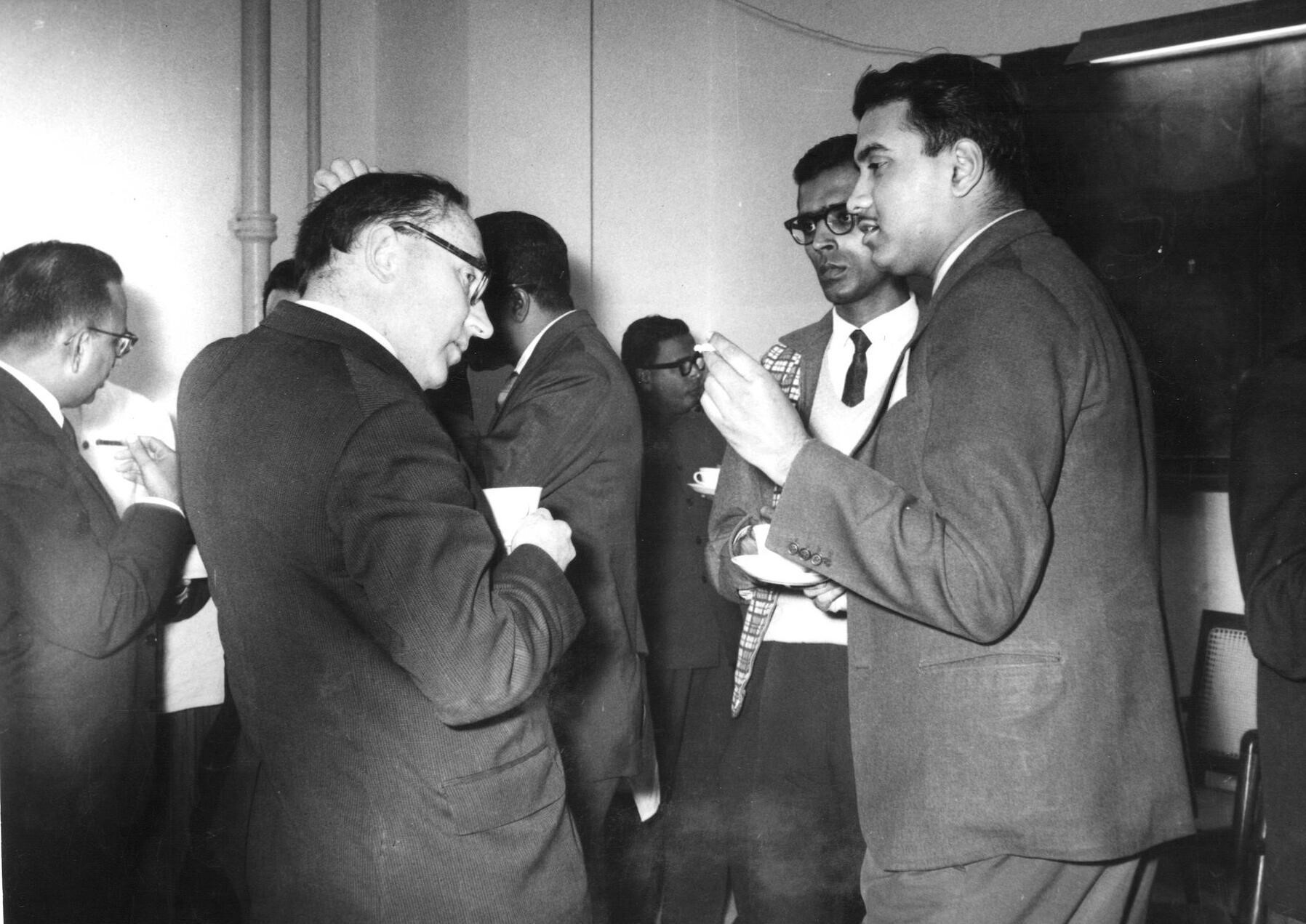
Professor Maurice Wilkes of Cambridge and R.N. Basu, Software Engineer, IITK Computer Centre in a discussion in Western Labs. Photo Credit: Prof. Gio Wiederhold
Professor Beltran from Mexico, one of the more colorful speakers, recounted stories of placing his IBM-1620 on an air-conditioned truck and hauling it around colleges in Mexico to let students learn programming. Most people did not quite know how to react to his recommendation for developing countries, “Buy your computer on time and then don’t bother to make the payments!”
And while there was a lot of serious discussion on the growth of Computer Science education, there was some fun stuff too… including elephant rides, and a side trip to the Khajuraho temples.
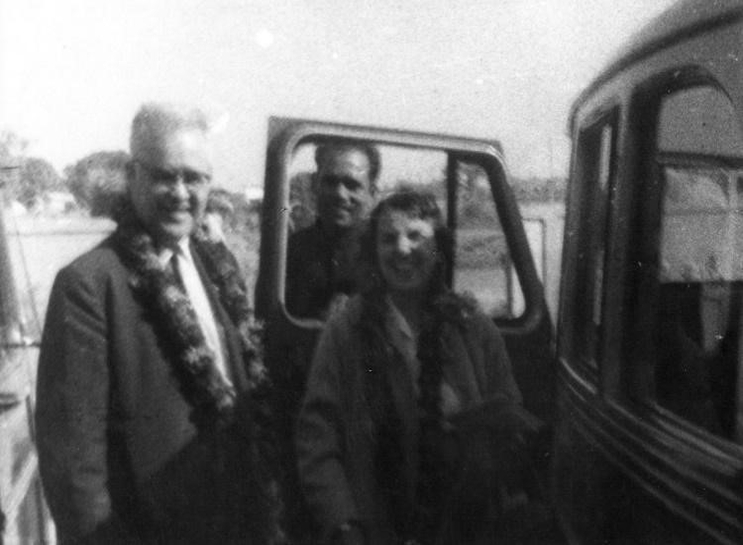

Left: Harry and Velma Huskey on the outing to Khajuraho. Right: Adriaan van Wijngaarden enjoying an elephant ride. Pictures are from the KIAP collection of Gio Wiederhold.
Credits: Information sourced from IITK Annual Report 1964-65, Harry Huskey’s autobiography “His Story”, Prof. Gio Wiederhold’s KIAP Collection, and Wikipedia. Compiled by Aseem Shukla, with thanks to Prof. Rajaraman for his recollections.
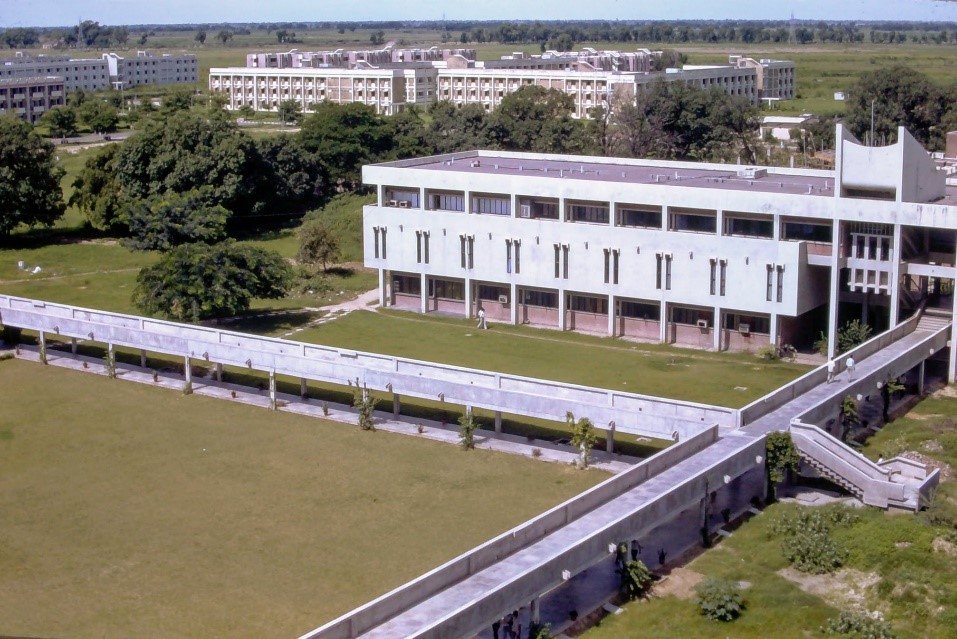
The Western Labs of IITK in 1967
(Picture Shared by Gyan Mehta, MSc Physics, 1968)
Our Experiences on the 1620
Ravi Sethi (BT, ME, 1963-68)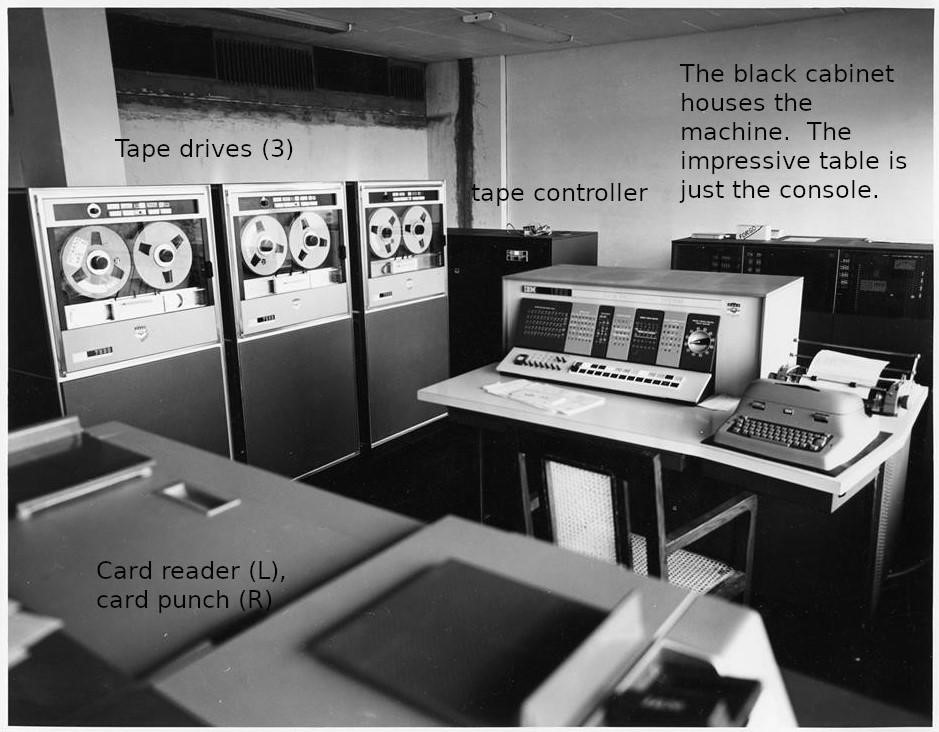
The IBM 1620 in its original home, at the end of the WL First Floor corridor.
Photo Credit: Prof Irving Rabinowitz, with components tagged by Prof. Hari Sahasrabuddhe.
This is a personal account, filtered through the lens of time, of events that took place 55+ years ago. It is from the perspective of a student, whereas the bigger picture is the role that the IITK computer center played in advancing computing in India. I believe the account to be accurate; my apologies in advance for any omissions and inaccuracies.
After the midterm exam in the fall of 1963, Prof. Forman S. Acton announced a short evening course on programming, for first year students. Later he told me that he had waited until after the midterm to select students based more on our grades in English than anything else. He was interested in assistants for the third-year course he was planning for Spring 1964. About twenty of us took the evening course, which featured a few short numerical analysis programs in FORGO, a version of FORTRAN.
Turning on the computer was an event
Six of us were selected to operate the IBM 1620. I recall being authorized to turn the machine on, which was an event in itself. First you had to turn on the generators that were housed in a small room to the right as you entered the computer center. The generators stabilized the unreliable supply of 50-cycle power and provided the 60-cycle power that the computer equipment needed. Then, you also had to turn on the air conditioning. Finally, you turned on the 1620.
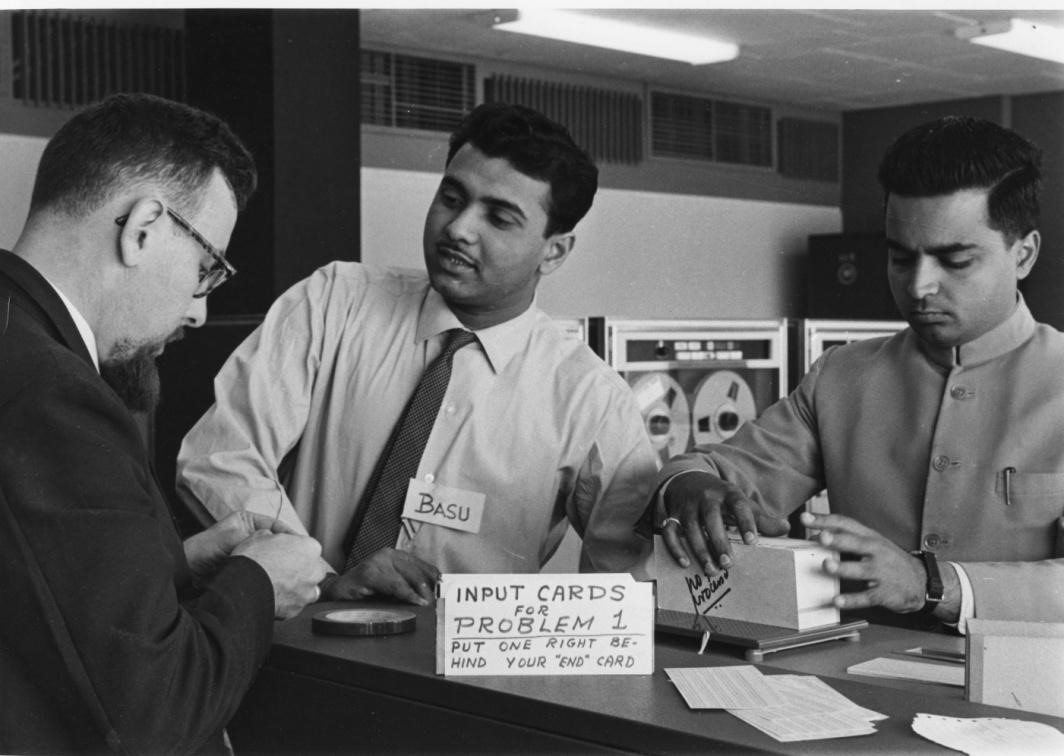
Working on a deck of computer cards. Prof Irving Rabinowitz is visible on the left, and R.N. Basu, a software engineer with the CC, is visible in the centre. Picture Credit: Prof Irving Rabinowitz, from the KIAP collection of Prof Gio Wiederhold
Running a program
Across from the 1620 was a bulky card reader that served as the input-output device. The tape drives had not yet been set up, so the card reader was ‘it’ for input-output. To run a program, you punched the code, line by line, on a deck of cards, one line per card, and handed the card deck to the operator. The operator added a “loader” card to the front. From the blinking lights on the console, we could tell if a program was in a loop and needed to be interrupted. With FORGO programs, the typewriter at the console would chatter to life. If it typed “PROGRAM” and paused, you knew that the next words would be “NOT ACCEPTED.” If the program was accepted, there was no pause. From the blinking lights on the console, we could tell if a program was in an endless loop and needed to be interrupted. After the computer had executed your program, the card “reader” produced a deck of cards with either error messages or your program’s output. You took the output deck to a bulky noisy line printer to get printed output.
The bigger picture
IITK interpreted its educational mission broadly. The idea was to bring knowledge of computers not only to IITK, but to the community at large. There were approximately 100 computers in India in 1964 and the Railways had 14 of them, the story went. The Railways had these computers in railroad cars, which they ran over a track to identify sections that needed to be improved.
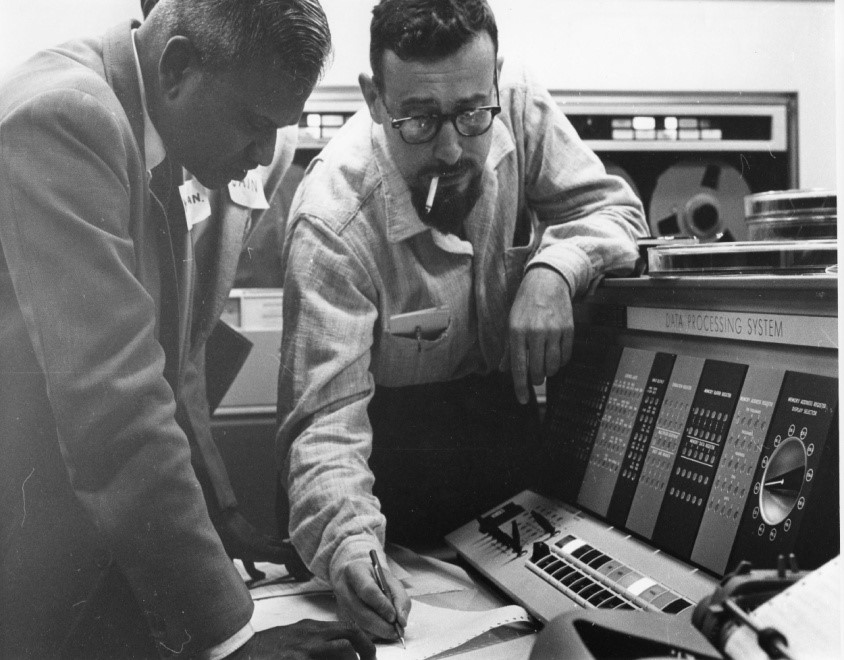
Prof Irving Rabinowitz maps out the solution to a problem. Picture Credit: Prof Irving Rabinowitz, from the KIAP collection of Prof. Gio Wiederhold
IITK was the first academic computer center in India. In his unpublished 1967 “Terminal Report,” Prof. Acton noted:
“In the relations with the outside world, the IIT-K Computer Centre is in good shape. It gives short courses, sponsors society meetings, makes its facilities available to qualified research scholars. It has a good public image.”
Culture shock
But there were cultural changes as well. As a small example, the third-year students had a hard time with us first-year students being the course assistants. Seniority mattered at the time. Seniority commanded respect. Just a few short months ago, they had been ragging us freshers. And, now here they were, handing over their card decks to be run on the 1620 and meekly asking for help with debugging. The third-year course soon went beyond topics that were covered in our evening course, beyond where we could help the students.
I’m harping on the role of seniority since it came up during short courses that IITK ran for the world outside the campus. There were instances of managers coming for a course rather than sending their technical people. And, when they got to the campus, they had to deal with 17-year olds. They got over it.
The Education Minister’s visit
The 1620 was popular with visiting dignitaries. One such important visitor was M. C. Chagla, the education minister at that time. I vividly recall him seated at the console being given a demo, which engaged him with a question-answer program. The program was simple. The first card held a question. The next card held the answer. The next couple of cards held the messages to be printed at the console in response to correct and incorrect answers. You could customize the demo by changing the cards. Chagla had no problems with the first few questions. He was a polished gentleman, dressed in a smart suit; he spoke impeccable English. For the next question, the 1620 typed:
“Where are we?”
The answer was obvious. Chagla typed “Cawnpore,” the old British spelling of the city, an answer that didn't match the next card in the deck. So, the program’s response was
“I thought we were in Kanpur”
The room went quiet. Chagla took it gracefully and laughed and the room laughed with him. Keep in mind that it was around 1965. The 1950 Indian Constitution had envisaged English names being phased out by 1965. The message from the program could have been interpreted as a rebuke.
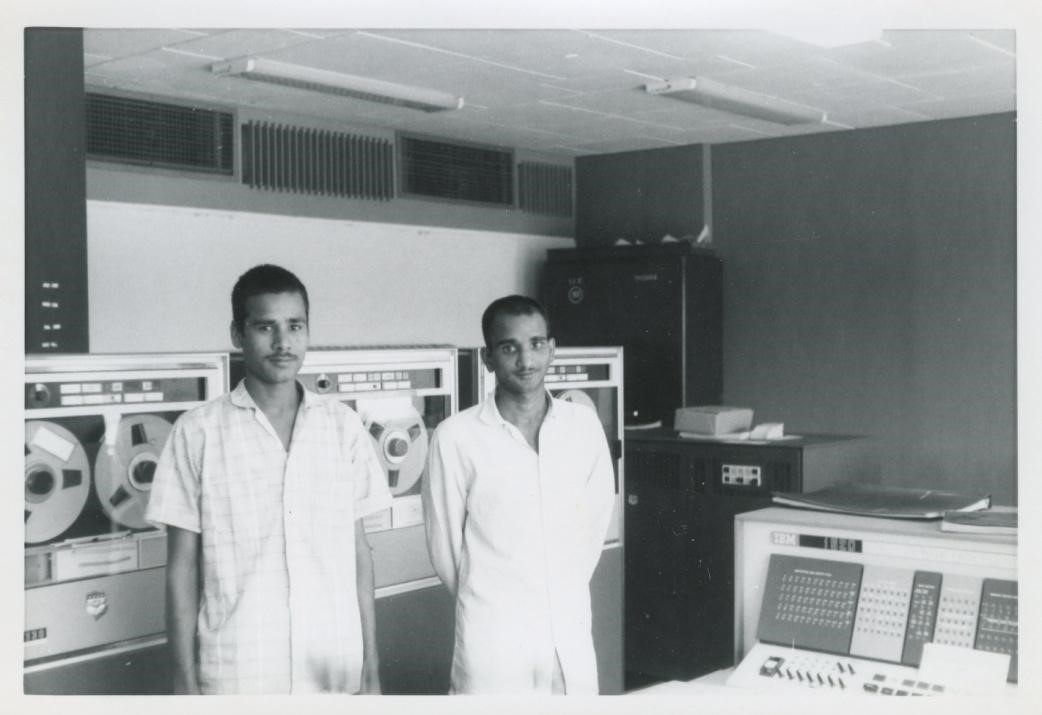
The caretakers of the 1620: R N Pande and M N Mishra were the computer operators. Image is from the collection of Prof Gio Wiederhold
How I got my summer job
At some point during the spring of 1964, Irv Rabinowitz and I were standing by the 1620 and the conversation turned to 1620 machine language. I had written FORTRAN programs, but had not yet been exposed to machine language. As I recall, Irv wanted a program that would copy a deck of cards. He asked if I would like to try and write one. He handed me a manual. The way the 1620 was set up, you started with a blank memory. It read the first card into memory and then executed it; that is, it followed the instructions on the first card. Ideally, Irv noted, the program to copy a card deck would fit on a single card: it had to be 6 instructions or less. The next morning, I handed Irv a working program on a single card.
That first machine language program was enough for Irv and Forman Acton to offer me a summer job at the computer center. Summer jobs were a new concept; my father wasn’t sure. He agreed after Forman wrote to him. I spent the summer working for Harry Huskey, who handed me a box of cards with a compiler for HH-1, Huskey’s Algol-like programming language. What did he want done? I was left to my own devices, reading assembly language to figure out what the box of cards did. I later went on to study compilers and write a textbook on the subject.
Prof. Acton’s retrospective
Years later, Forman gave me a copy of the report from his second semester-long visit in the fall of 1967. It begins as follows:
“For me this was a return visit. In 1963-64 I had helped Harry Huskey and Irv Rabinowitz establish the first academic computer center in India here at IIT-K. For one year we nurtured it, watched it grow beyond our hopes and expectations, and then suddenly we had to abandon it. Irv stayed on for a while and was succeeded by other Americans – but basically the lusty infant had been handed over to the Indians in the hope that it would prosper and grow. On balance, it has.
Now, in 1967, my mission was to return to IIT-Kanpur for one semester, bearing some programs that had proved useful in America, but were not yet available in India and were sufficiently complicated that transmission by mail would have been insufficient to secure their use. Verbal explanation would be needed, seminars would have to be conducted.”
Concluding remarks
Much time has passed since those early years at IIT/K. When I’m asked for advice, I don’t know quite how to respond. Computers were not on the horizon when my father advised 14-year old me: “With Mechanical Engineering you’ll always have a job.” I did major in Mechanical Engineering to please him, but other pursuits beckoned. IITK students are among the best in the world and have gone on to great things, not always in the fields they started with. When we put together a book for the 1963-68 batch’s 50th reunion, it was humbling to learn about all they/we had accomplished.
Aim for great things. You can do it too. As they say, the best way to predict the future is to invent it.
About the author:

Professor Ravi Sethi obtained his B.Tech in Mechanical Engineering from IITK in 1968. Part of the Frontier Batch of 1963-68, which was the first to start on campus, he was actively involved in campus activities including The Spark, the TV Centre, and the arts club. His stay on the campus coincided with the arrival of the IBM 1620 in July 1963. Fascinated by the new computer, he actively sought assignments in the computer centre, and in the process got to know Professors Acton, Huskey, and Rabinowitz. Prof Acton got him started with the 1620 and they stayed in touch for decades after IITK. In the summer of 1964, just before he returned to the US, Prof Huskey asked him to work on his compiler for HH-1, an Algol-like language.
The fascination with computers led to a PhD in computer science from Princeton. He stayed in touch with Prof. Rabinowitz as a graduate student. This in turn led to a 38-year career at Bell Labs and Avaya Labs, culminating as President of Avaya Labs from 2000-2014. He is currently Professor of Computer Science at the University of Arizona, Tucson, AZ, and is an author of several books on Compilers and Programming Languages. He was recognized as a Distinguished Alumnus of IITK in 2008.
From the Archives:
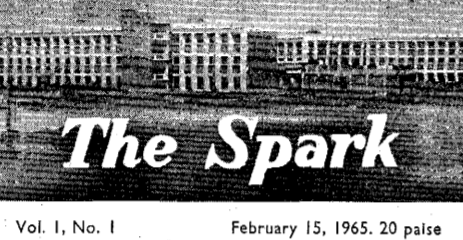
A Larger Computer for the Institute
IITK is going to be in the limelight again, for soon we are going to obtain a new computer and the faithful old 1620 will no longer be the sole centre of attraction. People at the Computer Centre have, in fact, already started talking flippantly about the 1620, referring to it as a mere toy! After learning about the new machine, we are inclined to agree with them. Perhaps the 1620 will be given to undergrads to tinker with, once the bigger machine is installed. But this rosy prospect is not altogether bright for there will still be formal courses on the 1620 as pre-requisites for further work.
Our correspondent, after an interview with Prof. Gio Wiederhold reports that the new computer is a whopper. The choice lies between the IBM 7044 and the CDC 3200, both of which are classed as large computers, though not super-large. These can handle all our engineering problems, and are also adapted to the solution of economic models. The Planning Commission is, therefore, very interested.

Since we already have so much IBM equipment, the 7044 seems to be the likely choice. It is a big-brained baby – its high speed (2 microseconds) memory can store 32,000 words and at 36 bits of information per “word” we hope we haven’t bitten off more than we can chew. The 1620 has only an eighth of this memory. This high-speed memory is augmented by eight magnetic tape drives, which allow reading of up to 20 million characters per reel of tape that takes about four minutes to be read or written. It has an elephant’s memory, but its speed would do an elephant credit. For example, an integer addition consumes only four microseconds; a floating-point multiplication twenty. Old 1620 does these operations in 960 and 12,512 respectively. The 7044 is voracious too, consuming 800 cards per minute. It prints out results at 600 lines per minute with 132 characters per line. Consider, a page of an ordinary exercise book carries about two hundred words only. But this too, is slow. The proposed final peripheral computer operation would allow speeds about 60 times as high. This works out to two microseconds for the output “Programme Not Accepted”, which is what we most usually see.
The overall computing capacity, then, of the 7044 is about 100-500 times that of the 1620. It will do many operations currently done manually, combining decks etc., and all this for a mere one hundred and fifty lakh Rupees*, not Dollars, cheap. But this places us on a par with major American universities, about 50 such computers currently in operation in their facilities. In India, we will be second only to Tata Institute’s CDC 3600. We will now be in a position to interchange programs with the leading computer centres of the world. A total of about 500 machines of this size exist in the world.
*List Price. IITK eventually got it at a 60% discount (that story follows in the next issue)
Conceptualized sketch of the IBM-7044 was created by the Outreach Cell, IITK

The IITK Computer Centre, 1977
(Picture Credit: Shirish Joshi BT, ChE, 1973-78)
Remembering Prof. Kesav Nori (1945-2021)
Chilukuri K. Mohan (BT, CSE, 1978-83)The summer of 2021 was darkened by the passing away of Prof. Kesav Nori, a beloved educator, researcher, and wonderful human being who had spent several years at IITK.
Prof. Nori came to IITK after graduating with a BTech degree in EE from IITB. His MTech thesis at IITK (1970), supervised by Prof. V. Rajaraman, was titled "A Critical Study of Computer System Performance Evaluation" and developed simulation models to compare different computers based on different goals and metrics. He then worked at the Tata Institute of Fundamental Research (TIFR) as a Research Scientist, participating in the development of a FORTRAN compiler and an assembler for the ECIL TDC 316 computer, and on the design of the operating system for an air defense system.
Prof. Nori interacted with Professors Dijkstra, Hoare, and Wirth, internationally renowned pioneers of Computer Science, during his 1974 visit to ETH Zurich (where he was well-known for writing the first Pascal compiler using P-code) and became passionate about structured programming and compiler correctness, propagating these critical ideas to early generations of computer science students at IITK where he taught during 1978-1981. He then spent two years at Carnegie Mellon University, returning in 1983 to join TRDDC, leading the institution later as Executive Director.
At TRDDC, Prof. Nori’s major contribution was bringing rigour into the programming process. He assisted in developing software tools that greatly simplified correcting the Y2K bug in COBOL programs. This enabled TCS to complete Y2K project assignments economically in record time. He introduced the ideas of using software tools and standardization in developing software systems at TCS. In 2003, he started a TCS research center in Hyderabad where he worked on the use of Indian languages in computing. His final stint as a Distinguished Professor at IIIT Hyderabad began in 2009.
Prof. Nori's endeavors sought clarity in the process of programming, so that we could reason about the products of programming, and have confidence in applications that relied on such products. From his perspective, programs needed to be written so that human beings could understand and reason about them, not just to be executed on computers. He alerted practitioners about the need for critical analysis at every level of the software development process, including the documentation of requirements and subsequent reliance on ossified specifications.
Building complex systems requires structure and organization, using smaller building blocks that are mostly self-contained and have limited interactions with other building blocks. These concerns led to Prof. Nori’s lifelong efforts to develop new generations of computer scientists who were capable of actively questioning and analyzing their work, thinking clearly rather than haphazardly patching code. For this, his former students are forever indebted to him: Prof. Nori brought structured programming to IITK, teaching the Pascal language for the first time in India, enthralling the first batch of CS students, and winning over many enthusiasts and converts from other disciplines as well.
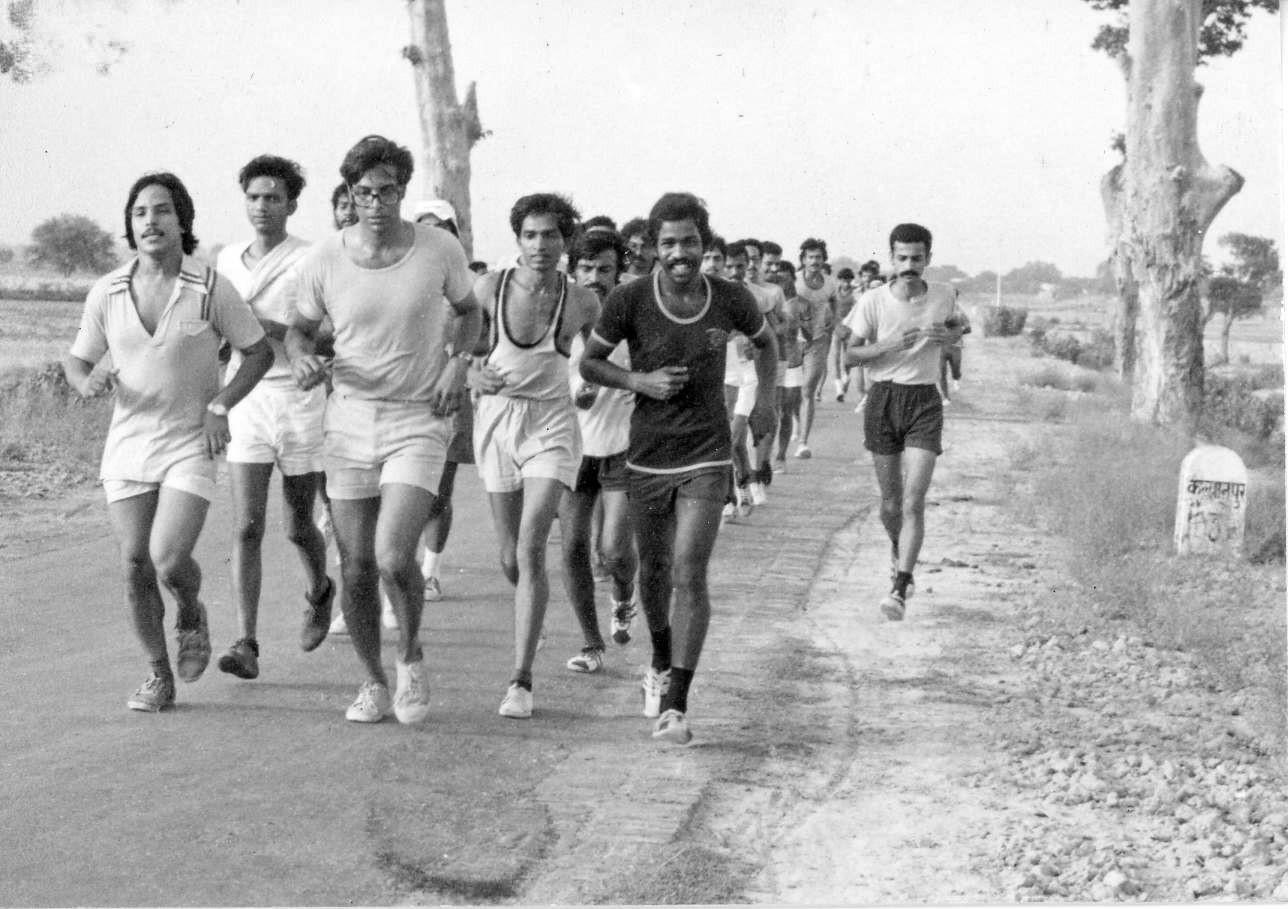
An image of Prof Kesav Nori as we remember him from his IITK days. This photograph depicts the Bithoor run of 1980, which was done as a practice before the main Lucknow run. Prof Nori is at the front center of the pack, leading the way, despite being the oldest person in the group. Picture has been shared by Amrit Yegnanarayan, who can be seen running on the right side of the pack.
At IITK, Prof. Nori was certainly not a one-dimensional professor. His students and colleagues remember him fondly for his interests as well as the nature of his interactions with the people around him. He was an avid reader of comics, worked on crossword puzzles, loved Carnatic and Hindustani music, and played tennis as well as Table Tennis. He was very fond of "Origami", the art of paper-folding that originated in Japan; this came to be known as "Norigami" to his friends and followers, whom he often delighted with his paper sculptures. He was an avid runner, and could be seen leading the pack in a famous 28 km run (IITK to Bithoor and back) in 1980. His colleagues at IITK appreciated his open-door policy, inviting anyone who wished to join him for a dinner conversation; he was also renowned for cooking special dishes for his friends.

On a return visit to IITK in 2010, Prof Nori is seen here at a panel discussion on the changing face of Computer Science. Visible here are former IITK Professors (L to R): Pankaj Jalote (later Director IIIT, Delhi), Rajiv Sangal (later Director of IIIT, Hyderabad), V. Rajaraman, Kesav Nori, and Gautam Barua (later Director IIT Guwahati). Picture is from the IITK CSE archives.
Prof. Nori was a constant source of encouragement for young people, urging them to develop and excel at their non-academic interests and hobbies. He paid attention to what they said: when a student challenged him because a mid-term test was too difficult, he agreed to arrange a make-up test. He respected, appreciated, and cared for his students, and was concerned about their well-being. He was always kind and helpful to all. He exemplified what an educator should be, and we remember him fondly. We’re glad to have known him, even if it has been for a very short period of time. More information is available at https://cse.iitk.ac.in/pages/InMemoriamKesav.html with articles by several of his former associates, and organized by Prof. Mainak Chaudhari.
From 1985. Nervously asking Dr KV Nori for a recommendation letter for Grad school despite bombing his Intro to Computing, Pascal class!

(Sketched by Raman Bhatia BT, ME, 1977-82)
Our Bits of That IITK
In October 2018 a few IITK Alumni created the Facebook group “This Bit of That IITK” with the intent of preserving IITK memorabilia, while reliving the cherished memories of our formative years. Over the past three years this group had grown to be 4,000 strong with probably the largest collection of current and historical IITK pictures, memorabilia, and anecdotes anywhere.
Much of the material released in this issue of Spark was conceived and written in the group postings which continue to celebrate everything IITK… from the mighty egg-coupon to the leaking jam-tin!
We welcome new members and would love for you to join the group. We welcome current IITK students, alumni, faculty, ex-faculty, administration and staff, and all others with valid IITK connections, and we do ask that you respond to the three screening questions so that we can validate your membership.
Here are some bits of IITK that we’d love to share…
From the New Yorker, Jan 1963
Innovation
We’ve just had word of a rather sinister movement that has arisen in Kanpur, an industrial town in the state of Uttar Pradesh, in India – a movement that may easily sweep the rest of the world any time now. Six or eight American families, whose heads come from MIT, Purdue, Carnegie Tech, and so on, are in Kanpur helping to bring into being the new Indian Institute of Technology, and while they were settling down there, they discovered that the local telephone system couldn’t provide them with telephones. The husbands, naturally, set to work to provide short-wave radio communications between the American dwellings, but materials were in short supply and the plan bogged down. Then one of the wives proposed that a boy be hired, equipped with a bicycle, and put into a more or less continuous orbit from house to house. This system has proved to be faultless, more reliable than short-wave radio would be and cheaper than telephones, and it has the added advantage of permitting books and other packages to be sent over at no additional cost. We are told that the first message transmitted by the lady inventor was “What hath God wrought?”
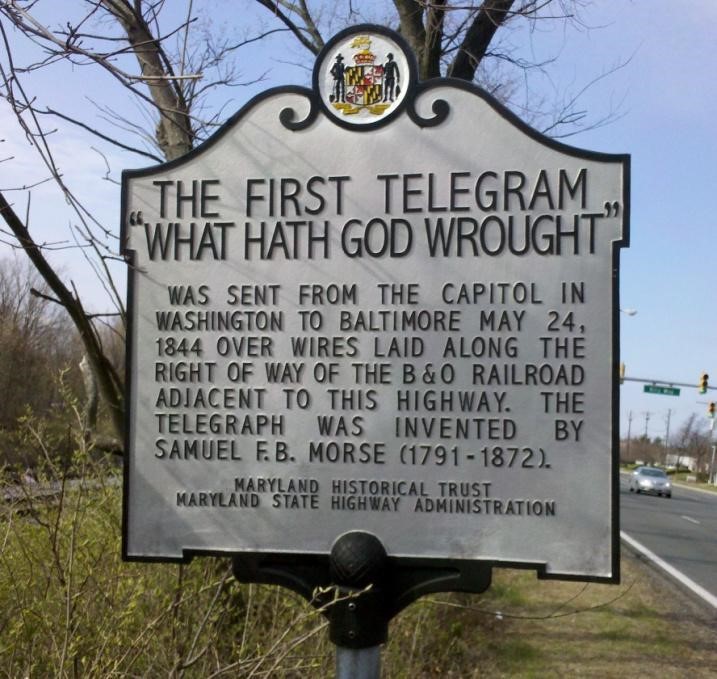
Credits: References to this passage, written by John Galbraith, also appear in his autobiography, Ambassador’s Journal, on page 412. The lady inventor was Mrs. Dorothy Dahl. The image of the Maryland Historic Marker has been downloaded from Wikimedia Commons.
You weren’t an Engineer if you did not have one!

Wonder how many engineers here can remember/recognize the objects shown in these pictures. In the late 60's, everyone in IITK had one of these. The two items have been with me since my IITK days.
The pocket-size one was my favorite. I carried it everywhere, just like people carry an iPhone now. This device still works. Its OS never needed an "update” and has remained unaffected by any virus/malware. The OS never became obsolete ☺. This fancy pocket size German device was the envy of all my classmates as most students only had a larger device -- typically about 0.3 m -- which did not fit in a pocket.
I am also including a "super-size" version in the picture, along with a standard 12-inch ruler for comparison. It was good for labs or such places. It was more accurate in some sense but more difficult to carry it with you.
Pocket size or medium size, virtually ‘everyone’ at IITK had this instrument.
So how many people can recognize these items? How many people know how to use them? ☺
(Gyan Mehta, MSc Physics, 1968)
Homework! Homework! Homework!
Copying homework from each other was a time-honoured practice. The original homework (from whoever did it first) would start getting distributed after dinner for further copying!
Of course, we, the JEE-Pass elite, claimed that we did "intelligent copying" which in practice meant that slight changes were made while copying to give the copy an original flavor for the benefit of the TA who would be grading it. This usually went on without a fuss and everybody would usually have their respective copies ready by breakfast time.
But mishaps did happen sometimes:
1. One of my batch mates got the homework late and had barely 20 minutes to copy it before the tutorial. He copied things so well that he even copied the Roll Number. Led to considerable misery later.
2. My roommate and I were once the original creators of a Chemistry homework solution which was duly sent out for copying just before dinner. Over a late-night cup of tea in the canteen, DM and I discovered a major flaw in our solution. We did not know how to reach everybody who had copied our version - did not even know who all had copied our version!! So, we did the next best thing -- we pasted a copy of the corrected homework solution on the door of the mess for people to use when they came for breakfast. Unfortunately, our batch mates did not appreciate our kind gesture! They thought we should have exercised greater care when making the original solution!
P.S.: I am relying on the fact that none of my current students are part of this Facebook group as I always tell them, very sanctimoniously, that copying homework is a sin which they should avoid!
(Sanjay Bose, BT, EE, 1971-76, Faculty EE 1982-2003, currently Professor EE, IIT Guwahati)
This Glass Remains Full
This Bit of That Hall 2 mess utensil… a steel glass stolen by me in 1976 or 77… still with me, and being used as my favorite drinking glass for drinking water daily even now after four decades The glass must have been brought to my room 366 with a sick food diet, and by chance remained with me -- then travelled to Hall 1 and my home.
My family took it for granted as a memoir given in IITK--but I know where it actually belongs--as it has IIT HALL 2 engraved on it!

(Manoj Kumar Srivastava, BT, CE, 1974-79)
Wings Over IITK
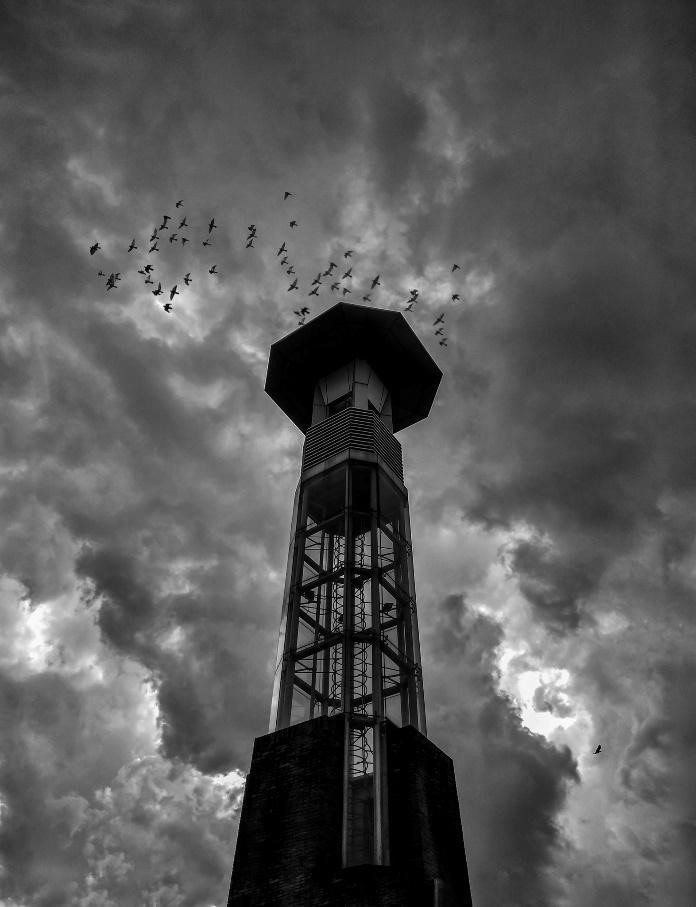
The SAC tower has surely replaced the Library fountain as the most photographed location on campus. Built during the construction of the new SAC in 2010, its top represents Jugnu, the satellite designed by IITK to provide data for agriculture and disaster monitoring.
(Krishnendu Paul, Research Scholar, Earth Sc., 2017- present)
Still Going!

This is the fan speed regulator from D-216 Hall 1 as clicked in Feb 2019. It has the names, batches, and departments of all the past occupants of this room since 1963 (well not quite, but they do go back to 1995)! Another thing to wonder about is the quality of old engineering and design which would be needed to make a regulator go through all these years. Yes! It is still working fine!
(Pranshu Garg, BT, EE 2015-19)
View From a Drone
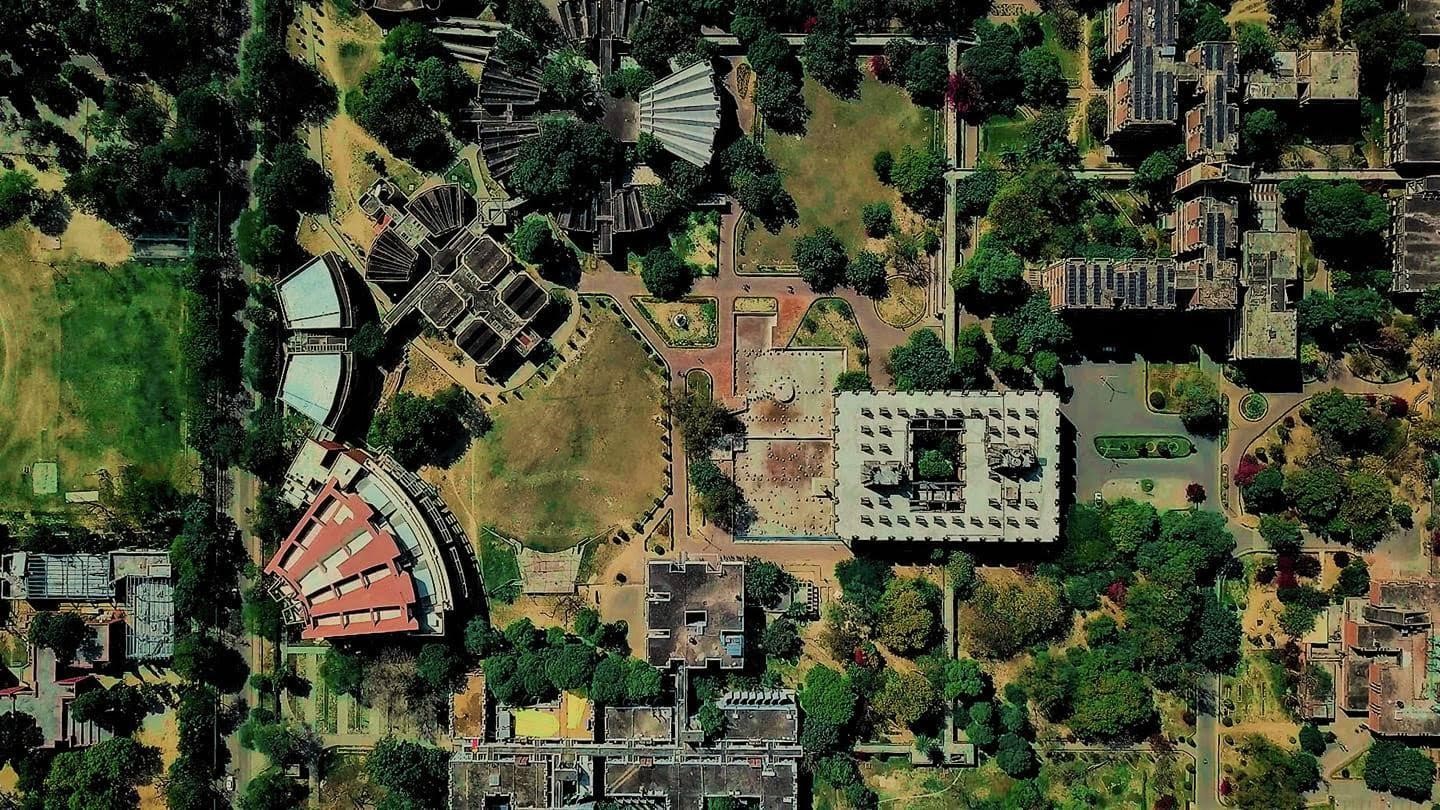
And yet another photograph justifying our obsession with this beautiful campus. That is the original LHC at the top, with Southern Labs at the bottom, and the new lecture halls lining up along the left side of this picture. This image from March 2019 was clicked by a group of drone enthusiasts, who are visible as the little dots near the wings of the eagle fountain. It will be great to see how this view appears once the campus has reopened and the transition of the fountain to a new water body is complete.
(Aditya Raghav Trivedi, BT 2018-22, BSBE)
An Idyllic Sunset in Kanpur Dehat

In the 1970s and 80s such evenings were visible behind Halls III and V, across the farmland stretching towards the Panki Canal. In fact, several photo books of that period have pictures of sunsets along the canal with the power transmission lines and the trees in the background.
As Kanpur’s urban sprawl enveloped the IITK campus, leaving behind an isolated oasis in the middle of a paved jungle, it is heartening to know that just a few kilometers away the view is still unchanged.
Here is a dramatic sunset clicked recently by Professor Praveen Kulshreshtha, of the Dept of Economics in Kanpur Dehat about eight km away from the campus.
(Praveen Kulshreshtha, Professor, Economics, 2009-present)
Cover Pictures:
Front Cover: IBM-1620 clicked by Prof. Irving Rabinowitz and taken from the KIAP collection of Prof. Gio Wiederhold; Param Sanganak clicked by Girish Pant, Sept 2021. The sketch of LHC is by Angshu Das, originally done for the photo yearbook This Bit of That India, 1975.
Back Cover: The IBM-7044 designed by the Outreach Cell, DORA office.
